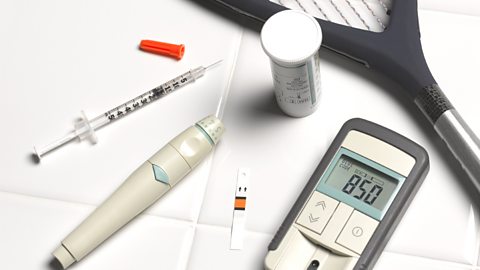Type 1 and type 2 diabetes
Greg Foot explains the difference between type 1 and type 2 diabetes and the role insulin plays in controlling glucose levels
Diabetes
diabetesA serious disease in which the body is unable to regulate blood sugar. is a condition where the glucoseA simple sugar used by cells for respiration. levels cannot be controlled by the body. There are two types of diabetes - type 1 and type 2.
Type 1 diabetes
Type 1 diabetes is a disorder in which the pancreas fails to produce enough insulin. This can be detected from an early age. It is characterised by uncontrolled high blood glucose levels and it can be controlled by injecting insulin.

People with type 1 diabetes have to monitor their blood sugar levels throughout the day. Their levels of physical activity and their dietThe type and amount of food consumed by people. affect the amount of insulin needed.
They can help to control their blood glucose level by being careful with their diet, and eat foods that will not cause large increases in blood sugar level, and by exercising, which can lower blood glucose levels due to increased respirationThe chemical change that takes place inside living cells, which uses glucose and oxygen to release the energy that organisms need to live. Carbon dioxide is a by-product of respiration. in the muscles.
Type 2 diabetes
In type 2 diabetes the person's body cells no longer respond to insulin produced by the pancreas. It is more common in older people. It can be controlled by a carbohydrateFood belonging to the food group consisting of sugars, starch and cellulose. Carbohydrates are vital for energy in humans and are stored as fat if eaten in excess. In plants, carbohydrates are important for photosynthesis. controlled diet and an exercise regime. Carbohydrate is digested into glucose, which raises the overall blood glucose level. There is a correlation between rising levels of body mass in the general population and increasing levels of type 2 diabetes.
Body mass index (BMIBody Mass Index, calculated by dividing a person's mass (in kilograms) by the square of their height (in metres).) is used to show if a person is a healthy mass for their height.
BMI = mass/(height)2
Commonly accepted BMI ranges are:
- underweight: under 18.5 kg/m2
- normal weight: 18.5 to 25 kg/m2
- overweight: 25 to 30 kg/m2
- obese: over 30 kg/m2
People who are overweight or obese have an increased risk of developing type 2 diabetes.
Scientific research has also indicated that people who have more weight around their waist are at a higher risk from developing certain illnesses, such as type 2 diabetes, than people who have more weight around their hips. This is determined by calculating waist to hip ratio:
Waist:hip ratio = waist measurement/hip measurement.
A waist:hip ratio of over 0.85 in women and 1 in men is considered an indicator of obesityThe medical term for being very overweight, owing to the excessive accumulation of body fat..
Question
Describe the pattern in this data.
Mean body weight has steadily increased
From approximately 72.5 kg in 1990, to 75.5 kg in 1997 up to just over 77 kg in 2000.
This matches a general increase in the number of people with type 2 diabetes from 1990 to 2000.
For example, the percentage was just below 5 percent in 1990 up to just below 7.5 percent in 2000. This shows an overall increase in 2.5 percent over 10 years.
Tip: Use the labels on the axes to help you describe the relationship between the data in the graphs.